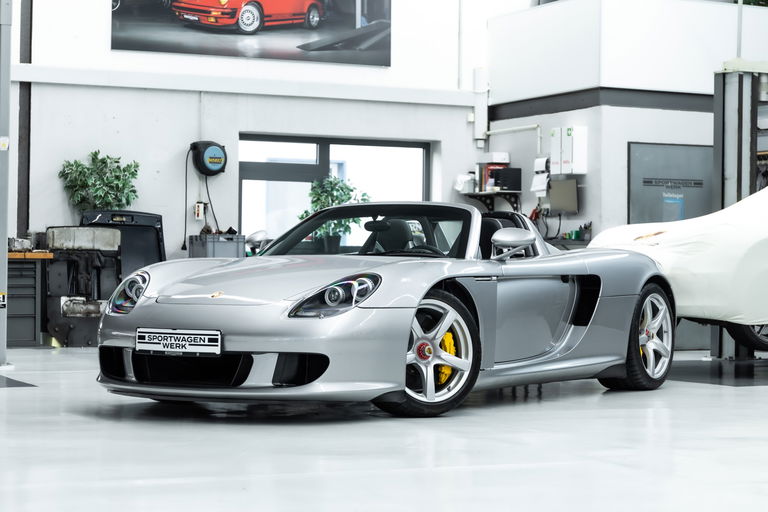The sweeping center console, door panels, and body panels were all fashioned from carbon fiber, as well as the composite carbon and kevlar fixed bucket seats. Atop the center console, a featherweight magnesium galvanized trim panel houses the switches and buttons. At the time, the Carrera GT was the epitome of modern-day extreme weight-saving measures. The days of stripping the car to its bare essentials in order to gain a competitive edge were left in the past in favor of well-engineered, lightweight composite materials that allowed for luxuries such as a Becker Porsche online Pro radio with integrated phone and navigation system, generous leather appointments throughout the interior, and the comfort of climate control while still maintaining weight to power ratio of 5.03 pounds per horsepower.
The 5.7 liter V10 in the 980 Carrera GT’s development can be traced back to 1992 when Porsche had developed a 3.5-liter engine with the Footwork F1 team for Formula One racing. Porsche’s engineers began the development of a replacement for the 911 GT1 for motorsport use in 1995, and revisited the shelved F1 engine as the basis of the engine for the Le Mans Prototype car, internally dubbed the 9R3. Porsche’s focus had shifted toward the development of the Cayenne, and as a result, further development of the Porsche LMP 2000 was abruptly canceled in 1998, but the modified version of the 3.5L V-10 engine that was being developed was not shelved for long. That glorious naturally aspirated, dry-sumped, 68º V-10 that had originally been built up to 5.5-liter specification for the LMP 2000 car was chosen to be at the heart of Porsche’s new supercar- the Carrera GT. Displacement was increased to 5.5 liters, a number that grew to 5.7 liters in production to offset the fact that the Carrera GT was 10% heavier than anticipated, so in order to keep the intended power to weight ratio, the engine block height was increased by 7mm to accommodate an additional piston ring and the bore diameter increased by 2mm. The production engine produced 604 horsepower and 435 ft-lb of torque with a redline of 8,400 rpms.
Only 1,270 Carrera GTs were produced for the global market in its short production run between 2003 and 2006, and have long been celebrated by those who have spent time behind the wheel for their impeccable handling and responsiveness. Many have exclaimed that the Carrera GT is the best thing that Porsche has ever created and that it is truly the last of the analog supercars. 18 years after its debut, the Carrera GT is still celebrated as one of the best supercars ever to come to market, and the values of these incredible machines have been steadily trending upward as a reflection of that sentiment by collectors around the world. This example has been pampered throughout its life and driven sparingly while being serviced at the recommended factory intervals, and presents in excellent condition throughout.






























































































